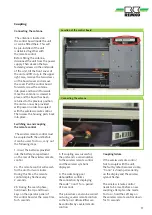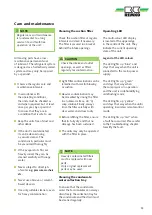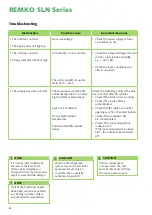
The condensation
of water vapour
Because the capacity for
the maximum possible volume
of water vapour increases as the air
is heated, the volume of water
vapour contained remains constant
and so relative humidity falls.
In contrast, because the capacity
for the maximum possible volume
of water vapour decreases as
the air is cooled, the volume
of water vapour contained remains
constant and so relative humidity
increases.
If the temperature continues to
fall, the capacity for the maximum
possible volume of water vapour
is reduced so much so that it is
ultimately equal to the volume of
water vapour contained in the air.
This temperature is referred to as
the dew point. If the air is cooled
to below dew point, the volume
of water vapour in the air will
become greater than the maximum
possible volume of water vapour.
At this point, the water vapour
begins to precipitate.
It then condenses to water.
Humidity is then removed from
the air.
Examples of condensation include
steamed-up window panes
in winter, or the moisture on
the outside of a cold drinks bottle.
As the relative humidity of the air
increases, so too does the dew
point, making it easier for
the temperature to fall below it.
Building materials and structures
are capable of absorbing
considerable volumes of water,
such as brick 90-190 l/m³, heavy
concrete 140-190 l/m³ and
limestone 180-270 l/m³.
The drying of moist materials such
as masonry is effected as follows:
■
The moisture
moves from
the inside
of the material
to its surface
■
Evaporation occurs on
the surface = transfer of water
vapour to the ambient air
Temp.
Water vapour content in g/m
3
at humidity of
°C
40 %
60 %
80 %
100 %
-5
1.3
1.9
2.6
3.3
+10
3.8
5.6
7.5
9.4
+15
5.1
7.7
10.2
12.8
+20
6.9
10.4
13.8
17.3
+25
9.2
13.8
18.4
23.0
+30
12.9
18.2
24.3
30.3
■
The air containing water vapour
is constantly circulated through
the REMKO air dehumidifier.
The air is dehumidified and,
slightly heated, leaves the unit
in order to re-absorb water
vapour
■
In this way, the moisture
contained in the material
is reduced gradually
The material is dried!
The accumulated condensate is
collected in the unit and drained
off from there.
Verdampfer
Kondensator
°C
30
25
20
15
% r.F.
100
90
80
70
60
50
40
30
20
10
+
+
-
Lufttemperatur
Luftfeuchte
Verlauf
Luftrichtung
Evaporator
Condenser
Air temperature
Air humidity
Air direction
% RH
Progression
As it flows through or over the evaporator, the air stream is cooled
to dew point. The water vapour condenses, and is collected
in a condensate trap from where it is drained off.
Drying materials
6
REMKO SLN Series
Summary of Contents for SLN 45
Page 2: ......
Page 25: ...1 10 2 3 4 5 6 7 8 9 11 12 13 14 15 16 17 18 19 21 20 22 Exploded view of the unit 25...
Page 34: ...Notes...
Page 35: ......







































